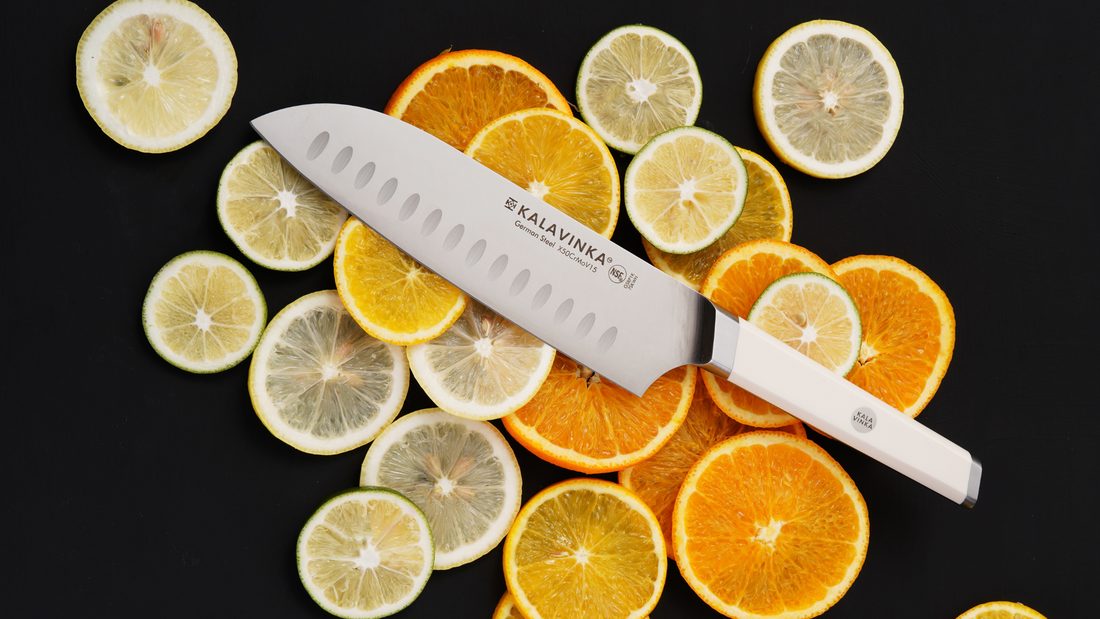
Tips on Sharpening Your German Steel Knife At Home
Share
Maintaining the sharpness of your KALAVINKA German steel knife is essential for optimal performance and safety in the kitchen. German steel, particularly X50CrMoV15, is celebrated for its durability, edge retention, and corrosion resistance. Regular honing and periodic sharpening will ensure your knife remains a reliable tool for all your culinary endeavors.
Understanding Honing vs. Sharpening
- Honing: This process realigns the knife's edge without removing significant material. Regular honing keeps the blade straight and maintains its sharpness between sharpenings.
- Sharpening: This involves removing material from the blade to create a new, sharp edge. Depending on usage, sharpening is typically needed a few times a year.
Tools for Maintaining Your KALAVINKA Knife
-
Honing Steel (Honing Rod): A honing steel is ideal for daily maintenance. Using it after each use will realign the blade and prolong its sharp edge. While it does not sharpen, regular honing reduces the frequency of sharpening needed.

-
Sharpening Stone (Whetstone): Whetstones are excellent for sharpening German steel knives. A medium-grit stone (around 800-1000 grit) is effective for establishing a good edge, while a finer grit (3000-6000) can be used for polishing.

-
Manual Knife Sharpener: Hand-held sharpeners are user-friendly and often come with preset angles suitable for German knives. They are convenient for quick sharpening sessions.

Sharpening Your KALAVINKA Knife with a Whetstone
- Preparation: Soak the whetstone in water for 10-15 minutes until air bubbles cease. Place the stone on a stable surface with a damp cloth underneath to prevent slipping.
- Angle Maintenance: Hold the knife at a consistent 20-degree angle against the stone. Maintaining this angle is crucial for achieving a sharp edge.
- Sharpening Process:
- Coarse Grit: Starting with the coarse side (if using a dual-grit stone), draw the blade across the stone from heel to tip, applying gentle pressure. Repeat this motion 5-10 times on each side.
- Fine Grit: Flip the stone to the fine side and repeat the process to polish the edge.
- Honing: After sharpening, use a honing steel to align the edge. Hold the honing steel vertically and draw the blade down at a 20-degree angle, alternating sides for 6-8 strokes.
- Cleaning: Rinse the knife with warm water and dry it thoroughly. Clean the whetstone as per the manufacturer's instructions.
Sharpening Your KALAVINKA Knife with a Manual Sharpener
- Select the Appropriate Slot: Manual sharpeners typically have multiple slots labeled for coarse and fine sharpening. Use the coarse slot for dull knives and the fine slot for regular maintenance or honing.
- Position the Sharpener: Place the manual sharpener on a stable, flat surface. Ensure it has a non-slip base or hold it firmly to prevent movement during sharpening.
- Insert the Blade: Hold the knife by the handle and insert the blade into the chosen slot at the base, where the blade meets the handle. Ensure the blade is perpendicular to the sharpener for even sharpening.
- Sharpening Process:
- Coarse Slot: Apply gentle downward pressure and pull the blade through the slot from heel to tip, following the natural curve of the blade. Repeat this action 3-6 times, depending on the dullness of the knife.
- Fine Slot: After using the coarse slot, move to the fine slot to refine the edge. Pull the blade through 1-2 times with light pressure.
- Cleaning: Wipe the blade with a damp cloth to remove any metal filings and dry it thoroughly. Clean the manual sharpener as per the manufacturer's instructions.
Additional Tips
- Regular Maintenance: Hone your knife after every few uses to maintain its edge. Sharpen the knife when honing no longer restores its performance.
- Proper Storage: Store your knife in a knife block, on a magnetic strip, or with a blade guard to protect the edge.
- Safe Handling: Always handle your knife with care, ensuring your hands are dry and the cutting surface is stable.
By following these guidelines and utilizing the appropriate tools, your KALAVINKA German steel knife will remain a precise and durable instrument in your kitchen for years to come.
